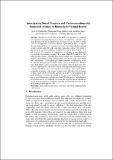Investigating Social Presence and Communication with Embodied Avatars in Room-Scale Virtual Reality
Author(s)
Greenwald, Scott W.; Wang, Zhangyuan; Funk, Markus; Maes, Pattie
DownloadPDF format included in proceedings. (9.099Mb)
Additional downloads
Metadata
Show full item recordAbstract
Room-scale virtual reality (VR) holds great potential as a medium for communication and collaboration in remote and same-time, same-place settings. Related work has established that movement realism can create a strong sense of social presence, even in the absence of photorealism. Here, we explore the noteworthy attributes of communicative interaction using embodied minimal avatars in room-scale VR in the same-time, same-place setting. Our system is the first in the research community to enable this kind of interaction, as far as we are aware. We carried out an experiment in which pairs of users performed two activities in contrasting variants: VR vs. face-to-face (F2F), and 2D vs. 3D. Objective and subjective measures were used to compare these, including motion analysis, electrodermal activity, questionnaires, retrospective think-aloud protocol, and interviews. On the whole, participants communicated effectively in VR to complete their tasks, and reported a strong sense of social presence. The system's high fidelity capture and display of movement seems to have been a key factor in supporting this. Our results confirm some expected shortcomings of VR compared to F2F, but also some non-obvious advantages. The limited anthropomorphic properties of the avatars presented some difficulties, but the impact of these varied widely between the activities. In the 2D vs. 3D comparison, the basic affordance of freehand drawing in 3D was new to most participants, resulting in novel observations and open questions. We also present methodological observations across all conditions concerning the measures that did and did not reveal differences between conditions, including unanticipated properties of the think-aloud protocol applied to VR.
Description
Submission includes video.
Date issued
2017-06-26Department
Massachusetts Institute of Technology. Media LaboratoryPublisher
Immersive Learning Research Network Conference, iLRN 2017
Keywords
room-scale virtual reality, copresence, non-verbal communication, collaboration